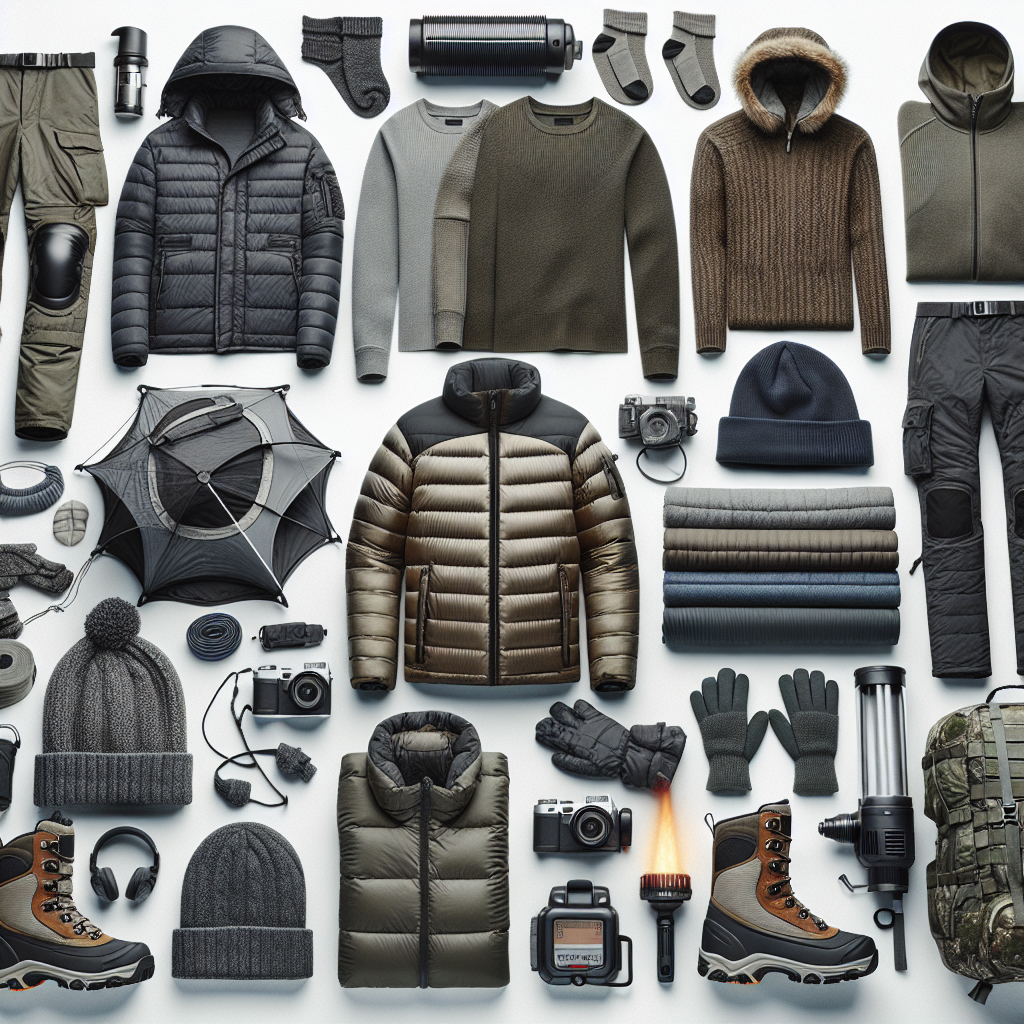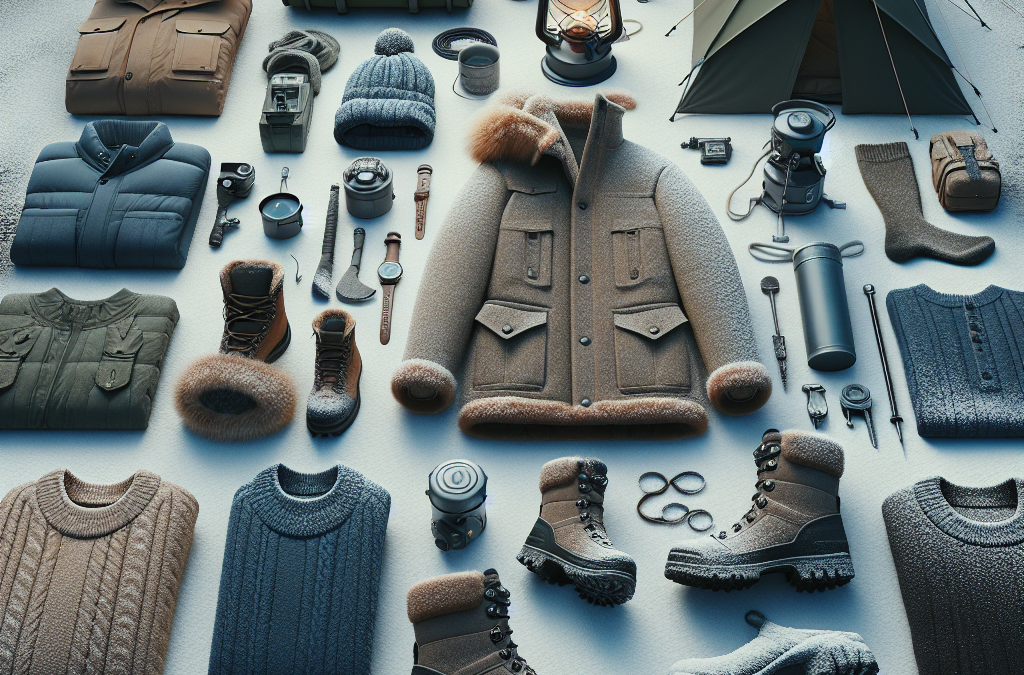Do you have a penchant for camping during the chilliest seasons? Then “cold weather Gear: Dressing for Winter Camping” is a compelling read you wouldn’t want to miss out on! In this insightful piece, you will find practical tips and critical advice on selecting the right attire to keep you warm and protected during your winter camping escapades. From the proper footwear to versatile layered clothing, this article embarks you on a journey that reshapes your cold-weather outdoor experiences, gearing you up to face the frostbite cold with confidence and comfort.

Understanding the Importance of Layering
Layering is more than just throwing on clothes to keep warm; it’s a strategic method of dressing, designed to adapt to the harshest and most unpredictable of conditions you may face during your outdoor adventure. When you layer properly, you maximize comfort and performance and decrease potential risks that come from exposure to cold weather.
The three-layer system
The three-layer system comprises a base layer, an insulating layer, and an outer shell. The base layer wicks away perspiration to keep you dry, the insulation layer retains body heat to keep you warm, and the outer shell protects you from wind, rain, and snow.
Regulating body temperature
Layering helps you regulate your body temperature. When you feel too warm, you can easily remove layers to cool off and prevent excessive sweating, which could make you cold. If conditions change or temperatures drop, adding layers can quickly provide extra insulation.
Adapting to changing conditions
Weather conditions, especially in winter, can change suddenly. Through layering, you can adjust to varying weather conditions without compromising your comfort or safety. That’s the beauty of layering – it offers flexibility and adapts to your body’s needs in response to the external environment.
Choosing Your Base Layer
Your base layer is crucial as it sits right against your skin. Its primary job is to manage moisture by wicking away sweat from your skin to keep you dry and comfortable.
Importance of moisture management
If your base layer doesn’t manage moisture effectively, sweat will remain on your skin, making you wet and inevitably chilly. On cold days, this can even lead to hypothermia. So, moisture management is essential to keep your body dry and your temperature regulated.
Material options: Synthetic vs. Merino wool
Synthetics like polyester are very popular for base layers. These materials are often more affordable and dry quickly. On the other hand, Merino wool is a great natural option. Soft and non-itchy, Merino wool can absorb a substantial amount of moisture and still keep you warm.
Optimal fit and considerations
Your base layer should be snug but not restrictive. It needs to have close enough contact with your skin to absorb sweat, yet not too tight that it impedes your movements. When choosing, consider any potential skin sensitivities to materials and the type of activities you’ll be doing.
Selecting the Right Insulation Layer
The insulation layer, or the middle layer, is meant to keep you warm by trapping body heat and preventing it from escaping.
Down insulation vs. Synthetic insulation
Down is very lightweight, warm, and compressible, making it a perfect choice for camping where space and weight matter. However, when it gets wet, it clumps and loses its insulating effects. Synthetic insulation is bulkier and heavier but offers insulation even when damp.
Factors influencing the choice of insulation
The right insulating layer will depend on many aspects, from anticipated weather conditions to your activity level. In damp climates, synthetic layers may be a better choice. When activity levels are high, a thinner insulating layer may suffice.
Finding the right balance between warmth and weight
You will want to find a balance between warmth and weight. If your insulating layer is too bulky, it might restrict movement and take up too much space in your backpack. A thinner, yet high-quality insulation layer can provide equivalent warmth and be less restrictive.
Finding the Perfect Outer Shell
Your outer shell functions as your personal portable shelter, defending you from wind, rain, snow, and sleet.
Defending against wind and precipitation
An effective shell protects you by blocking wind and repelling water. This conserves body heat that could otherwise be lost if you were to get wet or be exposed to wind.
Breathable vs. Non-breathable jackets
Your outer shell needs to prevent water from getting in but also let sweat get out. Breathable jackets have specialized materials and ventilation options like zippers under the arms. Non-breathable jackets, while excellent at keeping moisture out, may trap sweat inside and make you damp, then cold.
Choosing the right fit for mobility
A well-fitting shell allows for full range of motion and room for your base and insulating layers underneath without being overly bulky. Enough space ensures optimal insulation efficiency and ventilation.

Protecting Your Extremities
Your extremities are most vulnerable to cold as blood flow is usually directed towards your core. Protecting your extremities is crucial to avoid issues like frostbite.
Gear options for protecting the head
A lot of body heat is lost through the head. Beanies, scarves and balaclavas are excellent options to retain heat. In windy and snowy conditions, a hood on your jacket or a hat with flaps can protect your ears.
Choosing gloves or mittens
Both gloves and mittens have their benefits. Gloves allow for more dexterity, but mittens keep your fingers together, sharing warmth and keeping them warmer overall. Insulated, waterproof options are best.
Keeping feet warm: socks and boots
Your feet get cold easily, especially when wet. When choosing socks, avoid cotton, which holds moisture. Instead, choose wool or synthetics. Insulated, waterproof boots will help keep your feet dry and warm.
Importance of Good Footwear
Quality winter footwear is essential for warmth and safety. These should be waterproof, insulated and provide good traction.
Understanding the importance of insulation
Insulated boots provide more than just warmth. They create a barrier against cold surfaces and prevent heat loss. High-quality insulation can also wick away moisture, increasing the overall warmth of your feet.
Choosing between different types of boots
snow boots are a great option for camping in snowy conditions. They are waterproof, have rubber soles for better traction and are insulated for warmth. For hiking, you might want to consider insulated hiking boots designed for long-term comfort and support.
Using gaiters for additional protection
Gaiters are a great add-on. They cover the top of your boots and lower legs, keeping out snow, water, and cold air, keeping you warmer and dryer.
Staying Warm During Sleep
A good night’s sleep is crucial, especially when camping in cold weather. It helps restore your energy, keeps the mood positive, and supports physical recovery.
Choosing a winter sleeping bag
Opt for a sleeping bag rated for temperatures lower than you expect to encounter. Look for a sleeping bag with down insulation if weight and space are considerations, or synthetic insulation if you expect lots of rain or snow.
Use of sleeping pads
Sleeping pads are key to staying warm. They add insulation and prevent the cold from seeping up from the ground. Look for a pad with a high R-value, indicating how well it insulates you from cold surfaces.
Gear choices for tent insulation
Reflective blankets or liners can be used to boost the insulation of your tent. They reflect back body heat instead of letting it escape through the walls of the tent.
Maintaining Body Heat with Nutrition
Staying warm doesn’t just depend on gear. Food and hydration play a vital role in helping your body generate heat.
Optimizing diet for cold weather camping
Your body burns a lot of energy in the cold to keep warm. It’s important to consume enough calories and nutrients. Opt for foods that are high in protein and healthy fats, with plenty of complex carbohydrates.
Hydrating properly in freezing conditions
Hydration is crucial for maintaining body temperature and energy levels. Hot drinks or soups can provide both hydration and heat. Carry an insulated thermos to keep liquids warm.
Snacks and meals ideal for winter camping
In addition to meals, don’t forget to include snacks that can be eaten on the go. Energy bars, trail mix, and jerky are excellent choices. Warm meals should be high in calories and easy to cook, like instant soups or freeze-dried meals.
Active Wear for Winter Camping
Active wear is important as it needs to stand up to the demands of your activities while keeping you warm and dry.
Choosing the right fabric
Materials like polyester, nylon, or merino wool are good choices as they’re breathable and wick moisture away. Avoid cotton as it retains moisture and can make you cold.
Options for active wear during winter camping
Opt for active wear designed for cold weather. Insulated vests, breathable long-sleeved tops, and bottoms, and even thermal underwear will keep you warm without restricting your movement.
Managing sweat during activity
Activities can make you sweat, which can become dangerous in the cold. Wearing moisture-wicking and quick-drying active wear can help manage sweat, reducing the risk of getting cold when your activity level drops.
Ensuring Safety through Gear
Safety should always be a priority when camping, especially in winter conditions.
Importance of visibility in winter camping gear
Having gear with high visibility can help you locate your belongings or be found in case of an emergency. Consider adding reflective elements or choosing gear in bright colors.
Use of emergency heat sources
Emergency heat sources like hand warmers, emergency blankets, or a fire starter kit can provide additional warmth in a dire situation. They take up little space and could potentially save your life.
Additional safety gear recommendations
Other safety items include a reliable torch or headlamp, a whistle, and a basic first-aid kit. A GPS or a compass is also crucial in case you lose your way in the snow.
By taking the time to equip yourself properly with the right clothing and gear, you ensure a much safer, more comfortable and enjoyable winter camping experience. Remember, preparation is key for all successful outdoor adventures.

